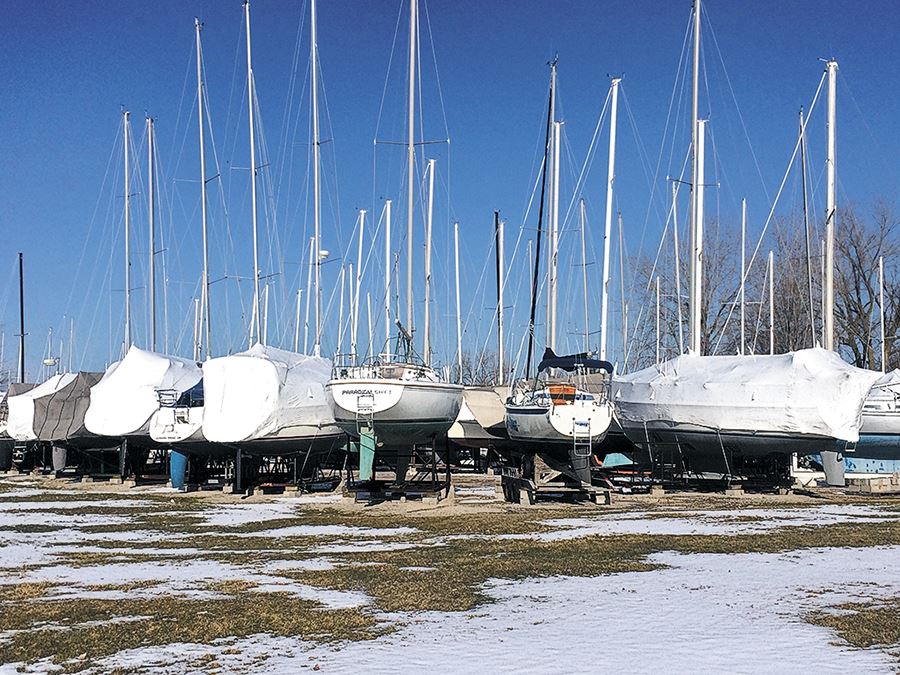
I’ve observed more than my fair share of errors people make when getting boats ready for the spring launch. I am quite sure that everyone has a few stories that have “happened to others.” One of my favorites was the steering system being incorrectly hooked up after some repairs; when launched the boat would turn left when the wheel was turned right…serious problem, particularly in reverse!
As sailing season is nearly upon us, there are multiple websites with lists on spring commissioning, each offering a slightly different take on the tasks that we all face as it is finally time to put the darned thing back in the water. My intent here is not to recreate the readily available list of what needs to be done, but rather to share some first-hand things that have worked well for me over the years.
From The Top Down
If you happen to have un-stepped your mast this is the perfect time to take a close look at the standing rigging, mast fittings and roller furling system. It is certainly easier to inspect with it lying at hip level than when you are hanging by a halyard, invariably with a helper or two moving around on the boat…causing just enough motion to make your job that much more difficult. Look closely for any broken wires, cracked fittings and rust. This can also be a good time to clean some of that winter dirt out of the sail track.
From The Bottom Up
It should be obvious to any sailboat owner that the most fun part of the spring launch process is the bottom of the boat. Do I need to sand or strip old paint? Should your plans require new paint, make sure that what you are applying is compatible with what is already on the boat. Paint technology is changing and improving all the time. Some old paint will need to be removed prior to new paint application while some will only need some light sanding.
Be sure to consider the options available at your marina and whether it is a job you can do yourself. My only recommendation is this: stripping the bottom—no matter the method selected—is never to be done with your significant other…just a suggestion!
Stuck In The Middle
The second most fun part of springtime work on the boat is the hull above the waterline. Cleaning and waxing a 30- to 40-foot boat is a job that seems to get bigger and somewhat more painful each year. This task, in my humble opinion, is better suited to someone under 20 years of age than someone over 60.
Hopefully, the sails were checked over after haul out in the fall and any needed repairs were taken care of over the winter. I have had the pleasure of helping a friend get his sails out of storage after the long winter only to find that they had made for a very nice nest for several families of mice. Needless to say, this did cause a slight delay in the start to his sailing season.
Some things can wait until the boat is in the water and some things cannot. Make sure to check the propeller, shaft and cutlass bearing. Check the state of your batteries and do a good visual check around the engine. Once in the water, check the bilges and if need be the bilge pump. Get the engine running and check fuel lines, water intake, gauges, etc.
In my world this is the time when we motor from the launch well to our dock. My hope is always that the trip from launch well to the dock is an uneventful part of the day. It might be a good idea to make sure that the engine is running smoothly before leaving the well…maybe even make sure that your anchor is aboard.
Now that we are at the dock the real fun begins. Cleaning the deck is a good place to start. Then check all the running rigging and get the sails on, tune the rig and tape the turnbuckles. Make sure the safety gear is up-to-date.
Organization Is Key
Given that I have four boats to maintain, some of the logistics of all this can be bedeviling. This is why I keep a spreadsheet of what needs to be done for each boat; not all have the same needs. One needs the transmission rebuilt, another wants a new propeller and cutlass bearing, while the third needs the dodger repaired, and the last one just needs to be sold.
Now you’re ready to sail! Don’t get too ambitious on the first run, just in case you’ve missed something. Make this a very safe and happy sailing season. Once you know you’re good to go, take some friends sailing who have never done so and show them a great time on the water.
About the Author
Tim McKenna is the founder of Erie Island Sailing School. He began sailing as a child on Lake Erie and, as they say, the rest is history. Tim competed in most of the Lake Erie races as well as more than a dozen Port Huron to Mackinac races.
Tim holds a USCG 100-Ton Masters license and is certified by the American Sailing Association to teach sailing. Having taught sailing across the United States, he decided to put together a sailing school where it all started for him: the beautiful waters of Lake Erie. He enjoys sharing stories of his sailing adventures, the fascinating people met and the fantastic boats sailed.
For More Information:
Erie Island Sailing School
www. erieislandssailingschool.com
412-951-1235

